
(a)
Interpretation:
The structural formula for
Concept Introduction:
In
In organic chemistry, reduction reaction is referred to the number
Alcohols undergo
Aldehyde undergoes oxidation to give carboxylic acid as the product while ketone does not undergo oxidation reaction.
(a)
Answer to Problem 16.45EP
The structural formula of the expected product is,
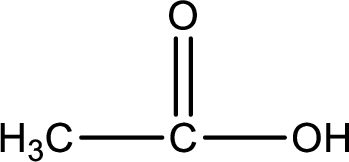
Explanation of Solution
Primary alcohol on oxidation gives aldehyde as intermediate product. This on further oxidation gives carboxylic acid as the product. The general scheme can be represented as shown below,

Given substance is,

This is a primary alcohol. The given compound is ethanol. Ethanol on oxidation gives ethanal as the intermediate product. The formed ethanal on oxidation gives ethanoic acid as the product. The complete scheme can be represented as shown below,

The carboxylic acid that is formed on oxidation of the given substance is ethanoic acid. The structural formula of ethanoic acid is given below,
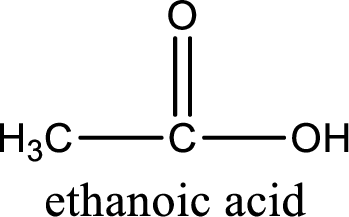
Structural formula of the carboxylic acid formed by the oxidation of given substance is drawn.
(b)
Interpretation:
The structural formula for carboxylic acid that is expected to be formed on oxidation of the given substance has to be drawn.
Concept Introduction:
In organic chemistry, oxidation reaction is referred to the number
In organic chemistry, reduction reaction is referred to the number
Alcohols undergo oxidation reaction and reduction reaction. This depends upon the number of hydrogen atoms that is bonded to the alpha carbon atom. Primary and secondary alcohol undergoes oxidation reaction while tertiary alcohol does not undergo oxidation reaction. Primary alcohols undergo oxidation to give aldehyde and carboxylic acid as product. Secondary alcohol undergoes oxidation to give ketone as the product.
Aldehyde undergoes oxidation to give carboxylic acid as the product while ketone does not undergo oxidation reaction.
Aromatic carboxylic acids are prepared from alkyl substituted benzenes.
(b)
Answer to Problem 16.45EP
The structural formula of the expected product is,

Explanation of Solution
Aldehyde on oxidation gives carboxylic acid as the product. The general scheme can be represented as shown below,

Given substance is,
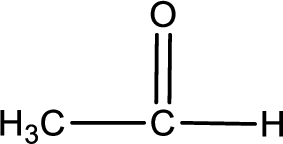
The given compound is ethanal and it is an aldehyde. Ethanal on oxidation gives ethanoic acid as the product. The complete scheme can be represented as shown below,

The carboxylic acid that is formed on oxidation of the given substance is ethanoic acid. The structural formula of ethanoic acid is given below,

Structural formula of the carboxylic acid formed by the oxidation of given substance is drawn.
(c)
Interpretation:
The structural formula for carboxylic acid that is expected to be formed on oxidation of the given substance has to be drawn.
Concept Introduction:
In organic chemistry, oxidation reaction is referred to the number
In organic chemistry, reduction reaction is referred to the number
Alcohols undergo oxidation reaction and reduction reaction. This depends upon the number of hydrogen atoms that is bonded to the alpha carbon atom. Primary and secondary alcohol undergoes oxidation reaction while tertiary alcohol does not undergo oxidation reaction. Primary alcohols undergo oxidation to give aldehyde and carboxylic acid as product. Secondary alcohol undergoes oxidation to give ketone as the product.
Aldehyde undergoes oxidation to give carboxylic acid as the product while ketone does not undergo oxidation reaction.
Aromatic carboxylic acids are prepared from alkyl substituted benzenes.
(c)
Answer to Problem 16.45EP
The structural formula of the expected product is,

Explanation of Solution
Aldehyde on oxidation gives carboxylic acid as the product. The general scheme can be represented as shown below,

Given substance is,

The given compound is 3-methylpentanal and it is an aldehyde. 3-methylpentanal on oxidation gives 3-methylpentanoic acid as the product. The complete scheme can be represented as shown below,

The carboxylic acid that is formed on oxidation of the given substance is 3-methylpentanoic acid. The structural formula of 3-methylpentanoic acid is given below,
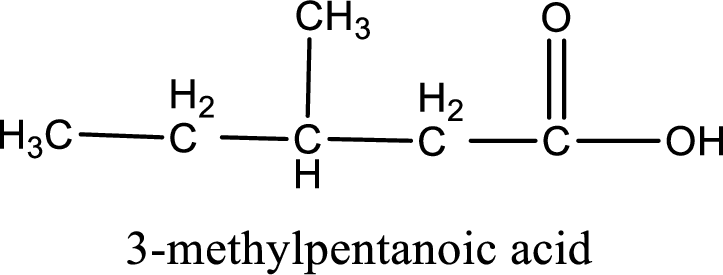
Structural formula of the carboxylic acid formed by the oxidation of given substance is drawn.
(d)
Interpretation:
The structural formula for carboxylic acid that is expected to be formed on oxidation of the given substance has to be drawn.
Concept Introduction:
In organic chemistry, oxidation reaction is referred to the number
In organic chemistry, reduction reaction is referred to the number
Alcohols undergo oxidation reaction and reduction reaction. This depends upon the number of hydrogen atoms that is bonded to the alpha carbon atom. Primary and secondary alcohol undergoes oxidation reaction while tertiary alcohol does not undergo oxidation reaction. Primary alcohols undergo oxidation to give aldehyde and carboxylic acid as product. Secondary alcohol undergoes oxidation to give ketone as the product.
Aldehyde undergoes oxidation to give carboxylic acid as the product while ketone does not undergo oxidation reaction.
Aromatic carboxylic acids are prepared from alkyl substituted benzenes.
(d)
Answer to Problem 16.45EP
The structural formula of the expected product is,

Explanation of Solution
Given substance is,
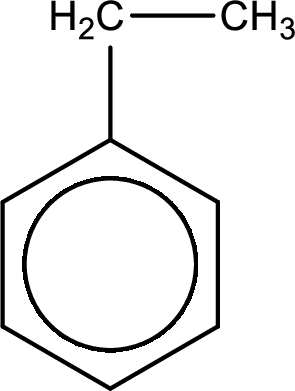
Oxidation of the alkyl side chain in a benzene derivative leads to the formation of aromatic acids. All the carbon atoms in alkyl group are lost except the one that is attached to the ring. The one carbon that is attached to the ring becomes a part of carboxyl functional group. This can be depicted as shown below,

The product formed is benzoic acid.
Structural formula of the carboxylic acid formed by the oxidation of given substance is drawn.
Want to see more full solutions like this?
Chapter 16 Solutions
General, Organic, and Biological Chemistry
- Which carboxylic acid has salts that are used to inhibit yeast and mold growth in the following? a. Ketchup and syrup b. Sauerkraut c. Pie filling d. Baked productsarrow_forwardIn terms of polarity, which carbonyl group atom possesses a a. partial positive charge b. partial negative chargearrow_forwardWhat is the geometrical arrangement for the atoms directly attached to the carbonyl carbon atom in a carbonyl compound?arrow_forward
 Organic And Biological ChemistryChemistryISBN:9781305081079Author:STOKER, H. Stephen (howard Stephen)Publisher:Cengage Learning,
Organic And Biological ChemistryChemistryISBN:9781305081079Author:STOKER, H. Stephen (howard Stephen)Publisher:Cengage Learning, General, Organic, and Biological ChemistryChemistryISBN:9781285853918Author:H. Stephen StokerPublisher:Cengage Learning
General, Organic, and Biological ChemistryChemistryISBN:9781285853918Author:H. Stephen StokerPublisher:Cengage Learning Chemistry for Today: General, Organic, and Bioche...ChemistryISBN:9781305960060Author:Spencer L. Seager, Michael R. Slabaugh, Maren S. HansenPublisher:Cengage Learning
Chemistry for Today: General, Organic, and Bioche...ChemistryISBN:9781305960060Author:Spencer L. Seager, Michael R. Slabaugh, Maren S. HansenPublisher:Cengage Learning Introduction to General, Organic and BiochemistryChemistryISBN:9781285869759Author:Frederick A. Bettelheim, William H. Brown, Mary K. Campbell, Shawn O. Farrell, Omar TorresPublisher:Cengage Learning
Introduction to General, Organic and BiochemistryChemistryISBN:9781285869759Author:Frederick A. Bettelheim, William H. Brown, Mary K. Campbell, Shawn O. Farrell, Omar TorresPublisher:Cengage Learning



